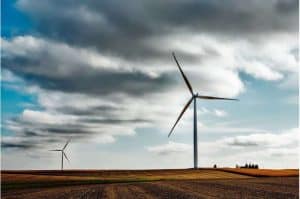
The economy of Southern Africa is rapidly developing, driving a growing demand for electricity. Efficiently meeting this demand will require balancing social, economic, geographic, technological and environmental considerations.
Researchers at UC Santa Barbara led an international team that analyzed the region’s resources and power grid. Using this data, they developed an energy portfolio that most effectively meets Southern Africa’s 2040 energy requirements, finding that wind and solar are the region’s most cost-effective options. What’s more, their model’s proposal effectively freezes greenhouse gas emissions at 2020 levels while doubling the amount of electricity the grid can produce. A detailed analysis appears in the journal Joule.
Currently, Southern Africa’s 315 million people use about 275 terawatt hours, roughly the same amount as California. “However, Southern Africa is expected to double its electricity demand by 2040,” said co-lead and corresponding author Ranjit Deshmukh, an assistant professor in UCSB’s Environmental Studies Program. “Developing the region’s excellent wind, solar and natural gas resources is the least expensive option for its consumers, and can meet this demand without increasing the region’s electricity sector carbon emissions.”
Deshmukh and his colleagues also found that in spite of doubling its electricity demand, the Southern Africa Power Pool (SAPP) may not need any coal power plants, nor would it need half of its planned hydropower projects, both of which have potentially enormous environmental impacts.
To reach these conclusions, the team employed a suite of models that account for a range of structural, climatic and economic factors. Deshmukh and co-author Grace Wu, also at UC Santa Barbara, developed one of the tools, called MapRE, in 2020. “MapRE allows us to identify suitable sites for wind and solar projects based on windspeed, solar radiation, proximity to transmission lines and road infrastructure, and land uses,” said Deshmukh, who leads the Clean Energy Transformation Lab (CETlab) and is a research associate at the Environmental Markets Lab (emLab).
Lead author AFM Kamal Chowdhury, a postdoctoral researcher in Deshmukh’s group, created a hydropower model called VIC-Res-Southern-Africa. This model estimates monthly electricity generation from existing and planned hydroelectric dams.
The authors took the data from MapRE and VIC-Res, as well as existing and planned generation and transmission capacity, and fed it to an electricity planning model called GridPath, which was developed by Deshmukh and co-author Ana Mileva. This model output a recommended energy portfolio. Both the model and the datasets are opensource and publicly available.
The results were encouraging. “If technology and fuel costs follow anticipated trends,” the authors wrote, “wind and solar technologies are likely to dominate future electricity generation investments in Southern Africa, and thus be the dominant source of electricity in the region by 2040.”
Notably, the model suggested that coal power won’t be competitive with these renewable energy sources. “The current fleet of coal power plants are old and expensive to operate,” said co-author Kudakwashe Ndhlukula. “With deeper regional integration, it would be uneconomic to operate these power plants anyway.” Ndhlukula is the executive director of the Southern African Development Community Centre for Renewable Energy and Energy Efficiency (SACREEE), an inter-governmental organization that includes the 12 countries in the Southern African Power Pool.
With financial support from global climate funds, such as the Green Climate Fund, the region’s coal-fire powerplants could even be retired early, the authors noted. The model predicted that taking the power stations offline 10 years early would increase electricity costs by only 4% annually. This could further decrease greenhouse gas emissions by 22% compared with 2020 levels.
The researchers also found that Southern Africa requires much less hydropower than anticipated. There’s a lot of additional hydropower in the Southern African Power Pool plan, and there’s plenty of potential to develop this resource, Deshmukh noted. “But, using the SAPP’s cost assumptions for hydropower—and the latest wind, solar and battery storage costs—we found that our model did not choose almost half the planned hydropower projects,” he said. “Basically, it’s not cost-effective to invest in those projects.”
The team also ran a model that included an 80% clean energy target. Under this goal, an optimal portfolio would cut the region’s 2020 emissions in half by 2040 while only increasing costs by about 6%, or $3 per megawatt hour.
In addition to planning how Southern Africa will generate electricity, efficiently meeting its energy demands will require international cooperation. “Regional integration is key to unlocking the immense potential of renewable energy for a cost-competitive electricity system in the region,” Ndhlukula said.
A robust electricity market and the transmission capacity to support it will also be crucial. “Wind and natural gas resources are unevenly spread out across southern Africa,” Deshmukh said. “Having a robust transmission system will help countries to trade and benefit from each other’s resources.”
Fortunately, the region already has an electricity market with interconnected transmission lines in the form of the SAPP. “It’s a question of expanding and scaling that market,” Deshmukh said. The model suggests that this can be accomplished with a moderate increase in transmission infrastructure.
The SAPP has 12 mainland countries, nine of which are physically interconnected through a shared grid as of now. Malawi’s connection will be completed by 2023, and there are plans to add the remaining two: Angola and Tanzania.
This is the first of four papers the team has produced as part of a larger project focused on Southern Africa’s energy future. They are currently analyzing the results of a stakeholder and policymaker survey to understand barriers to introducing renewable energy in the region. And they are looking at the possible biodiversity impacts of different renewable energy sources. Lastly, the group plans to assess how climate change could impact the energy sector.
“This particular paper is based on current environmental conditions,” Deshmukh said. “The next paper will include the influences from climate change.”
